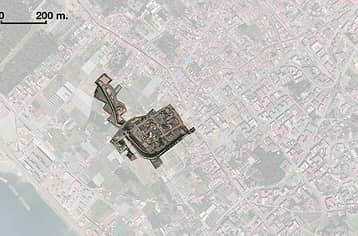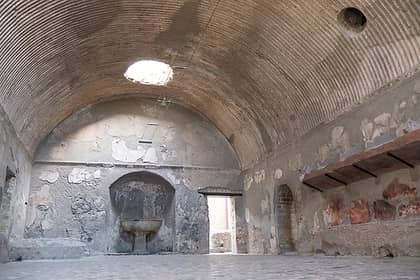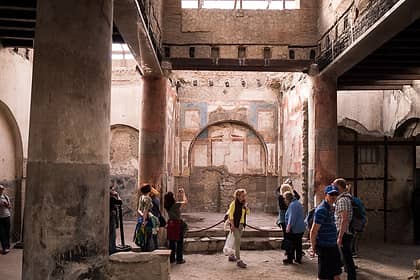- Home
- Visiting The Ruins of Herculaneum
Visiting The Ruins of Herculaneum

Tickets for Herculaneum archaeological park
It's possible to visit all of Herculaneum in just a few hours, as opposed to Pompeii.
The archaeological park is ideal stop for those who have limited time but want to experience the thrill of walking in the footsteps of the ancient Romans!
The archaeological park is ideal stop for those who have limited time but want to experience the thrill of walking in the footsteps of the ancient Romans!
Herculaneum has been preserved like no other site in the world, not even nearby Pompeii. The city was buried beneath 16 meters of ash and mud during the eruption of Mount Vesuvius in 79 AD, and this layer of detritus saved two-story domus homes with the internal architecture and décor intact, including features in wood and marble, decorations, jewelry, and even organic remains like food, providing a unique view into the daily lives of the ancient population of Herculaneum.
We suggest spending at least a half day exploring the Herculaneum Archaeological Site; follow our itinerary to see the most important buildings in the site in 2-3 hours.
In addition to an itinerary, we suggest the top sights to see along the route on this page, which are marked with the same numbers as the official map provided free of charge at the entrance to the ruins. You can also download the official map following the link below.
Herculaneum Opening Hours
16 March – 14 October: Opening: 08:30, Last admission: 18:00, Closing: 19:30 (site must be vacated by 19:00)
15 October – 15 March: Opening: 08:30 Last admission: 15:30 Closing: 17:00 (site must be vacated by 16:40)
Open every day except 1 January and 25 December.
Ticket Types and Prices
Tickets can be purchased at the official ticket offices located at the park entrances or through the online ticketing service.
Several ticket options are available.
Ticket Type / Pass | What It Includes / Validity | Full Price | Reduced / Youth (18–25) / Free* |
|---|---|---|---|
Regular Entrance Ticket | Admission to the archaeological park | €16.00 | €2.00 for EU citizens aged 18–25 |
“Ercolano Card” Annual Pass (individual / family / youth) | Unlimited access for 365 days during regular opening hours | - €30.00 (individual) | — |
Free or special reduced admissions | As per national regulations (e.g. minors, seniors 65+, special free days) | — | Free or reduced according to eligibility |
*Children under 18 enter for free but must still obtain a free ticket.
Summary of the reviews: pros and cons
Visitors tend to be pleasantly surprised by Herculaneum. Many describe it as more intimate, better preserved, and easier to explore than Pompeii. The wooden structures, the upper floors of the houses, and the vivid colors of the frescoes make the site feel astonishingly alive. Reviewers also appreciate the calmer atmosphere: it’s smaller, less crowded, and far more manageable to visit without feeling overwhelmed.
On the downside, several people note that the site’s size is both a strength and a limitation — it’s more compact, but that also means less variety if you expect a full-day archaeological marathon. A few mention that some areas or houses are occasionally closed without clear explanations. Others feel that information panels could be improved or that hiring a guide makes a big difference because the site’s history isn’t always intuitive at first glance.
Practical tips
Go with a guide or a good audio guide: the site is dense with details that are easy to miss.
Great alternative to Pompeii if you want a calmer experience: fewer crowds, easier to navigate.
Plan 2–3 hours: it’s not huge, and you can explore it thoroughly without rushing.
Bring water and sun protection: the site has more shade than Pompeii, but the heat still hits hard.
Wear comfortable shoes: the ancient streets are uneven, even if the distances are shorter.
Check opening times and access areas: some houses may be closed unexpectedly.
Combine it with the MAV museum (just outside the entrance) if you want a more immersive understanding of the eruption.
A Brief History of Herculaneum
A Brief History of Herculaneum
Herculaneum is named for the mythical Greek god, Hercules, who, according the legend told by Dionysius of Halicarnassus, founded the city in 1243 BC. Historic analysis, however, suggests that the city was founded by the Oscans or the Etruscans in the 7th century BC , conquered by the Samnites in the 5th century BC. In 90 BC the city was dominated by Rome and transformed into a municipium. In the final years of the Roman Republic, Herculaneum reached the height of its splendor thanks to its coastal location, clean air, and mild climate, making it a popular resort town for many of Rome's patrician families. The city was vibrant and densely populated when the earthquake struck in 62 AD, causing serious damage; work to rebuild the city was still going on when the tragic eruption of Mount Vesuvius happened in 79 AD.
The cloud of toxic gases from the eruption wiped out the inhabitants, while the entire city was literally sealed under a flow of ash and volcanic rock 16 meters deep that solidifiedi, preserving almost perfectly intact organic remains like fabric, food, vegetation, and wooden structures.
Visiting the Crater on Mount Vesuvius
The discovery of the ruins at Herculaneum was a complete accident: while a well was being dug in 1707 by order of Emmanuel Maurice, Prince of Lorraine, a number of marble fragments and statues that once decorated the ancient theater of Herculaneum were unearthed. In 1738, work began again under Charles III of Bourbon led by the Spanish military engineer De Alcubierre. In 1755, after a number of important discoveries were made, the Accademia Ercolanense was established, and was active until 1792. Excavations were suspended a number of times over the years until 1927, when the site began to explored in a more systematic way. Important artifacts were unearthed in the 1980s, along with sites like the Temple of Venus, the baths, and the ancient Greek port where the inhabitants tried to find refuge in 79 AD. The site has been home to intense excavation since 2000, especially around the Villa of the Papyrus and the library.
Two to Three Hour Itinerary
Two to Three Hour Itinerary
Sites to visit beginning from the Corso Resina 187 entrance ( Circumvesuviana “Ercolano Scavi” stop long the Sorrento - Naples line)
House of Argus (40)
House of the Skeleton (42)
Thermopolium (38)
Men's Baths (26) *
Double Atrium House (25)
Hall of the Augustals (24) *
House of the Beautiful Courtyard (28)
House of Neptune and Amphitrite (29)
Women's Baths (27)
Samnite House (31) *
House of the Wooden Partition (36) *
Large Taberna (10)
House of Relief of Telephus (7) *
House of the Deers (8)
Terrace of M. Nonius Balbus (2)
Fornici (1) *
Legend
* The main sights to visit
Area + number on the official map in parenthesis
Visiting the Herculaneum Archaeological Park with Kids
Visiting the Herculaneum Archaeological Park with Kids
Visiting the Herculaneum Archaeological Park with small children can be difficult as the site's ancient Roman roads and sidewalks are not easy to navigate with strollers and pushchairs. We suggest using an infant carrier or backpack for children who are too young to walk, and leaving any wheeled strollers at the free bag check area at the entrance. Otherwise, you can follow the walkway that encircles the perimeter of the site with a stroller or pushchair, viewing the ruins from above.
Older children enjoy visiting the MAV (Virtual Archaeological Museum), located a short walk from the entrance to the Herculaneum Archaeological Park.
This museum has a virtual, interactive exhibition that recreates ancient Herculaneum as it was before the violent eruption in 79 AD that destroyed the city. There are 70 multimedia displays with reconstructions, installations, and holograms that illustrate the Herculaneum, Pompeii, Stabia, Baia, and Capri ruins in an entertaining and engaging way.
MAV - Hours
Tuesday - Sundays from 10am to 6pm (last entry)
MAV - Tickets
Museum + 3D Film: EUR 11 adults; EUR 9 children under 13, seniors over 65, students, teachers, and Artecard members; free entrance for children under 5.
Family tickets (2 adults + 2 children): Museum + 3D Film EUR 34.
Museum tickets can be purchased at the ticket office or online.
Purchase MAV tickets online.
Where to Eat
Where to Eat
There are no picnic areas or restaurants/cafés inside the Herculaneum Archaeological Park. Before entering, there is a small snack bar next to the book shop where you can purchase beverages and snacks.
To eat nearby, you can walk to a number of restaurants and cafés in the immediate area for either a sit-down meal or take-away.
We suggest:
Viva Lo Re (tel: +39 081 739 0207) Located along Corso Resina, this restaurant has an excellent wine cellar with a number of Italian and international labels and a menu that varies weekly.
Tubba Catubba (tel: +39 081 344 3503) This delicious informal eatery is also on Corso Resina just minutes from the ruins and serves fish, meat, and traditional regional dishes.
Pizzeria Luna Caprese (tel: +39 081 777 1543) For an delicious Neapolitan pizza at great prices, this is an ideal choice.
Top Herculaneum Sites
Tickets for Herculaneum archaeological park
1. Men's Baths (26)
1. Men's Baths (26)

The Terme Centrali (Central Baths) date from the second half of the 1st century BC and were fully excavated in 1931. Like all baths, they were divided into areas for men (Termi Maschili) and for women. Walk through the apodyterium (changing rooms) with the wall niches to store clothing to the three bathing areas: the frigidarium (cold room), the caldarium absidato (hot room), and the tepidarium, with its beautiful black and white mosaic depicting Triton surrounded by dolphins, octopi, squids, and a cupid.
2. Hall of the Augustals (24)
2. Hall of the Augustals (24)

This magnificent square structure was seat to the College of the Augustales, free men who were devotees of the cult of the Emperor Augustus. Columns, arches, cocciopesto floors, and two splendid frescoes: on the left wall, there is a depiction of Hercules entering Mount Olympus accompanied by Jupiter, Juno, and Minerva; the fresco on the right wall depicts Hercules wrestling Achelous. The skeleton of the building's custodian was found in his quarters, laid out on the bed.
3. Samnite House (31)
3. Samnite House (31)

One of the oldest houses in the city, the House of the Samnites was built in the 2nd century BC and is famous for its beautiful Greek-style atrium painted in the Fourth Style (characteristic for its depiction of fantastical architecture and dramatic scenery), floors in cocciopesto, marble impluvium (rainwater pool), and a faux loggia upstairs with three sides lined in Ionic columns and the fourth (east) side open.
4. House of the Wooden Partition (36)
4. House of the Wooden Partition (36)

The name of this home comes from the wooden partition (tramezzo di legno) that survived the eruption and is still standing in its original location. This folding door separated the atrium from the rest of the room, lending the inhabitants privacy, and has a series of folding panels with brass handles and holders for hanging lanterns.
5. House of Relief of Telephus (7)
5. House of Relief of Telephus (7)

Built between 27 BC and 14 AD on the panoramic ridge overlooking the marina, this three-story home was decorated with a number of sculptures from the Neo-Attic school, including one with a relief of Telephus (Rilievo di Telefo), son of legendary found of the city, Hercules. The atrium is lined with columns supporting the upper floor, and the spaces between them were decorated with oscilla, or marble discs with reliefs of Dionysus used to guard against evil spirits.
6. Fornici (1)
6. Fornici (1)

The fornici were the port warehouses (also used to shelter boats) located along the beach that was about 500 meters closer to the city in Roman times. In 1980, 300 human skeletons were unearthed here belonging to residents attempting to flee the eruption in 79 AD and killed by the scorching clouds of toxic smoke and ash created by the volcano. Along with their remains and personal objects like jewelry and coins, a nine-meter long Roman ship with skeletons of the rower and a soldier with his belt, two swords, chisel, and purse with coins were found.
FAQ - Frequently asked questions
How long does a visit to Herculaneum take?
Is Herculaneum or Pompeii better if I have limited time?
Is Herculaneum suitable for small children?
Is Herculaneum accessible for visitors with reduced mobility?
Where is the entrance to Herculaneum?
What are the must-see highlights at Herculaneum?
Why is Herculaneum better preserved than Pompeii?
Do I need a guide to visit Herculaneum?
Are there cafés or restaurants inside the site?
Can visitors see the Boathouses where the skeletons were found?
Is the MAV worth adding to the Herculaneum visit?
Is there a suggested route to see the highlights quickly?
Is it safe to visit Herculaneum today considering its proximity to Vesuvius?
Can you visit Herculaneum from the Amalfi Coast?
Visiting Herculaneum from the Amalfi Coast is possible, but it’s considerably more complex than departing from Naples or Sorrento because it requires at least one transport connection. From Amalfi or Positano, travelers must take a bus or ferry to Sorrento, then continue by train along the Naples–Sorrento line. Not all trains stop at Ercolano Scavi, and at certain times a change at Torre Annunziata is required. To avoid missed connections and long transfers, booking a guided tour with included transportation is usually the most reliable and time-efficient option.